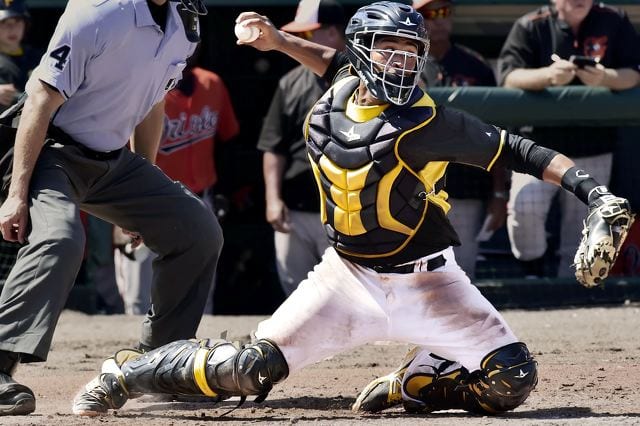After losing Russell Martin to free agency in the 2014 offseason, the Pittsburgh Pirates seemed thin at one of the most important positions in baseball.
Just one year later, catcher may just be the deepest position in the entire Pirates system.
With both Triple-A prospect Elias Diaz and Single-A catcher-of-the-future Reese McGuire making an appearance in MLB’s Top 10 catching prospects list, the future backstop situation looks very bright indeed.
Almost as bright as its present.
The Pirates backfilled the loss of Martin with unheralded former Yankee Francisco Cervelli. Heading into the 2015 season, Cervelli was notable for never having played a full season. In dealing with injuries and a suspension stemming from his link to the Biogenesis performance-enhancing drug scandal, Cervelli never got on solid footing in New York. The Pirates brass took a chance on Cervelli, as they saw great value in his pitch framing. Indeed, it was an absolute asset in 2015.
For those unaware, pitch framing is a catcher’s ability to make a borderline pitch look to be a strike. The Pirates began emphasizing this as part of their run prevention plan in 2013, and Martin’s ability in this area led directly to his signing the then-largest free agent deal in team history. Last year, Cervelli’s pitch framing was the most effective in all of baseball. RAA, or runs above average, is the key metric here, measuring a catcher’s ability to save runs via pitch framing. Cervelli came in with a 26.7 rating for the year, a full four runs better than the second-place finisher.
The approach is felt at all levels of the organization. Last week, the Pirates officially inked backup catcher Chris Stewart to a two-year extension, with a third year being held as a team option. Stewart will never be confused with Cervelli offensively, but is a very capable backup. Stewart’s pitch-framing numbers have always been consistent throughout his career. With the steady efforts of the two catchers on the big-league club, the team maximizes the ability of the pitching staff to throw strikes on a consistent basis.
In the minor league system, there is no question that McGuire is the catcher of the future. After struggling in 2015 as part of the Single-A Advanced Bradenton Marauders, McGuire showed very well in the Arizona Fall League, hitting for a .294 average and a .791 OPS (on-base percentage plus slugging). His timeline for joining the majors still points toward 2018. The organization will look for further improvement from him as he will presumably start the year with Double-A Altoona.
Diaz is not without his own amount of acclaim. Recently named Baseball America’s top catching prospect, Diaz has quickly made a name for himself with his defense. Diaz threw out 30 percent of would-be base stealers during his 2015 season at Triple-A Indianapolis. He has caught 29 percent of runners for his career and has a plus arm. It should be no surprise that he also excels at pitch framing, with consistent high marks. His offense is catching up, with a .271 average in 2015.
Late in the year, Diaz saw time on the Pirates’ bench when rosters expanded in September. Though he did not make a start and was hitless in two at-bats, the mere fact that Diaz was there ahead of then-Pirate Tony Sanchez spoke volumes of how the club feels about his future.
With a promising future in tow, the Pirates will lean heavily on the present catching talent to extend their recent window of competitiveness.



